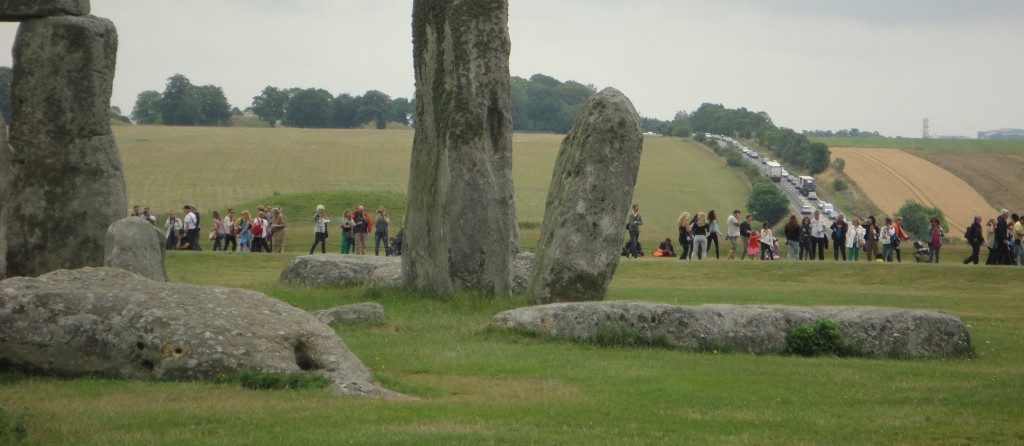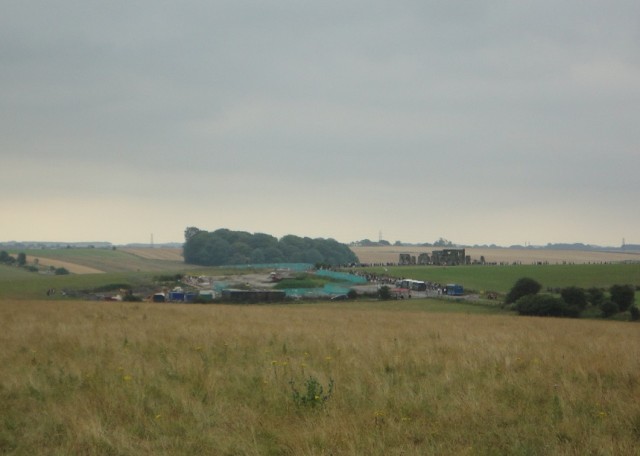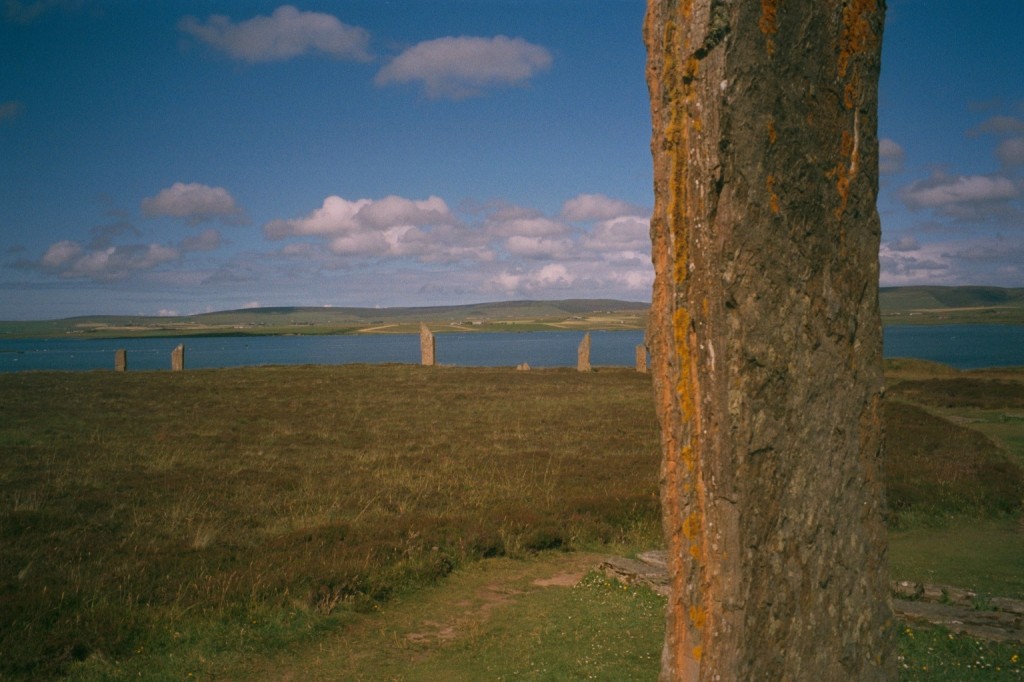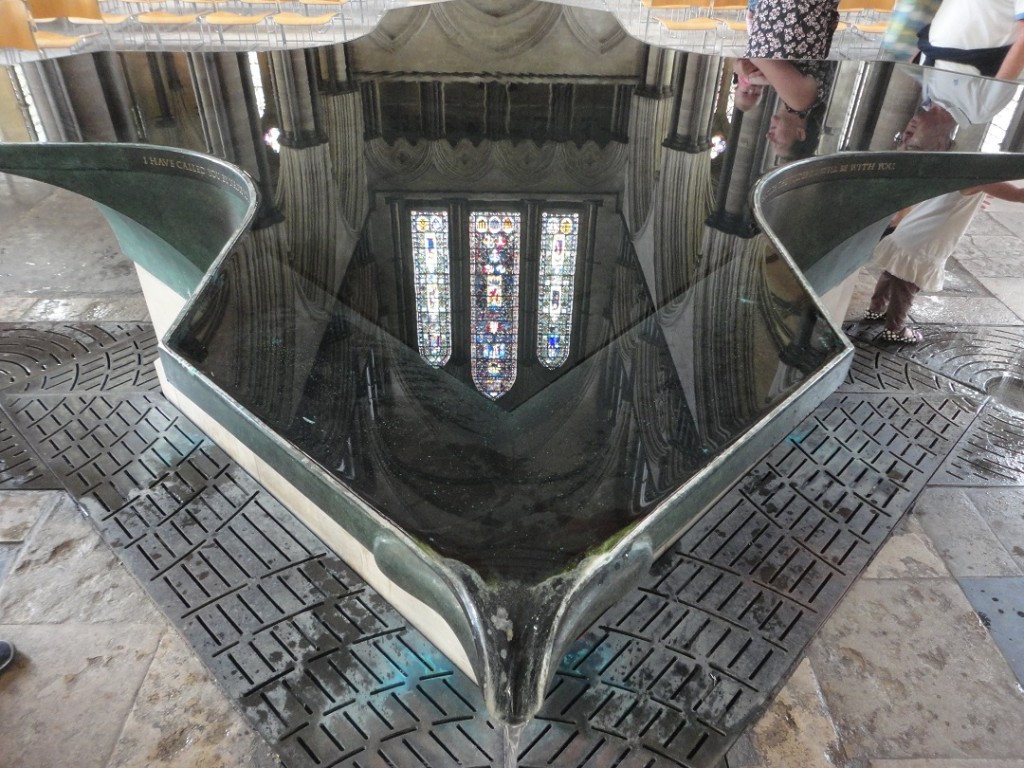Stonehenge’s new visitor centre is a huge improvement on what it replaced, but it remains difficult to appreciate the stone circle with a jammed-up major road just a field away. You can do better a few miles south.
First published on Beacon.

British arguments over land and access are nothing new, and people have been arguing about how to manage visitors to Stonehenge for more than a century. In 1901 the Antrobus family fenced off Britain’s most famous stone circle and started charging an entrance fee. Earlier this year English Heritage – the government body that runs hundreds of historical sites, with Stonehenge as both its flagship and biggest headache – opened a new £27m ($46m) visitor centre, more than a mile from the stones and out of sight behind a hill. It is a vast improvement on what it replaced in all sorts of ways.
Nevertheless, for reasons which will become apparent, you can do better than Stonehenge. Visit an ancient place of worship just a few miles south, with amazing architecture, treasures beyond price, far fewer visitors and a significantly smaller entrance fee. And it’s still in use. But first, your correspondent visits Stonehenge so you don’t have to.
The new Stonehenge visitor centre has a far bigger car-park than the old one. The centre itself has a lot in common with Gloucester Services on the M5, in that it tries to fit in with the landscape with a metal canopy over two buildings, one faced with glass, one with planks of wood, even if the latter looks a bit like a branch of Hollister. It replaces a set of cramped temporary buildings right by the stones, so this is an improvement.
But given it is purpose-built on a fairly spacious site, it is surprising to see queues for the ladies toilets. Sadly, it is less surprising to see signs on the ticket desks saying that English Heritage will not tolerate verbal or physical abuse of its staff. Last year, it cost £8 for an adult ticket. The price for those turning up on the day is now £14.90; the timed-entry ticketing may mean you can’t even get in immediately; and when you’ve done so, you aren’t even in sight of the stones. Visitors who simply want to see Stonehenge are paying more for worse access.
Visitors’ hackles may be raised by other niggles. English Heritage strongly encourages people to book a timed-entry ticket in advance online, and knocks £1 off for doing so, but at the entrance signs don’t direct pre-payers. Also, given the guide book is available in eight languages, it might be an idea if these signs were in more than just English: the car park alone featured vehicles with numberplates from the Czech Republic, Denmark, France, Germany, Hungary, the Netherlands, Poland, Spain and Switzerland.
Take a hike
To get to the stone circle from the visitor centre, visitors now need to take a ‘land train’ – a Land Rover Discovery pulling along three little carriages, supplemented by more conventional minibuses – or walk. Walking is better. The marked route is along a sealed-off road now used only by English Heritage vehicles, and they give walkers lots of space.
However, a better bet – certainly from Fargo Plantation, the intermediate drop-off point for the land trains – is to walk across the open access land that surrounds the stones. Taking the main path north-east from the plantation will add only a few minutes to the walk, but you will pass several Cursus Barrow burial mounds and see Stonehenge in its environment: an atmospheric, rolling landscape, where the weather can change in minutes. Bring an umbrella or anorak. This advice applies at pretty much all times and places in Britain anyway.
There should be a sign from the road to tempt walkers onto this diversion – perhaps one will appear when demolition of the old visitor centre and car-park is complete. By other means, including the visitor centre exhibition and the guidebook, English Heritage encourages visitors to explore the area around Stonehenge itself, which is astonishingly rich in ancient sites.

It is good advice. Standing out in the wide open spaces, you can get a sense of why Stonehenge and its area was an awesome and sacred place, worthy of a great temple. Visitors can walk around the surrounding area for free, although the visitor centre car-park costs £5 for those not buying an entry ticket. But good luck in trying to feel a sense of awe when standing next to the stones.
The main reason Stonehenge itself disappoints is not the hundreds of other people around you: there is quite a bit of space to the south of the stones, and the timed ticketing stops it becoming a crush. It would be good to get closer, but it would also be good for Stonehenge to survive the million-plus visitors it gets every year, and the low ropes now in place certainly beat the old barbed wire. And although the old visitor centre and car park is still being demolished, it is just far enough away to ignore.
The problem is that Stonehenge is just 200 yards from the A303, one of the main roads linking London to the south-west of England. As it enters the Stonehenge World Heritage Site, the A303 narrows from two lanes in either direction to one. Britain’s greatest stone circle sits a field away from one of its greatest traffic pinch points.
English Heritage and the National Trust, the massive charity that owns much of the land around the circle, tried to fix this during the years spent reworking Stonehenge. They did get another road that ran even closer to the stones closed (and caused even bigger jams on the A303, as a result of vehicles waiting to turn across the opposite stream of traffic). As for the main road, the government has several times proposed putting it into a tunnel, but it would have cost a small fortune and its building would have disrupted an archaeologically priceless area. Another alternative, putting the A303 into a long, deep tunnel, would cost a big fortune.
The road could have been diverted, but as usual in Britain the question was: where? To the north is Salisbury Plain, with large areas used by the military for training: the Larkhill barracks are only a mile away. To the south lies more gorgeous scenery (much with its own archaeological merit) and beautiful towns. The one benefit of the status quo is that bored children, stuck in a traffic jam on the way down to Cornwall, often get a good look at Stonehenge – at no cost to their parents.
The new and improved Stonehenge experience is a step up from the old one. The facilities are much better, the mass catering is well done (particularly the freshly-baked pasties) and English Heritage is rightly encouraging visitors to look at the whole area, not just the traffic-noise blighted circle.
Other neolithic monuments are available
But there are better options. If you want to see ancient stone circles, burial mounds and homes, go to the Orkney Islands. The Ring of Brodgar is more spectacular than Stonehenge, and you can park nearby and walk around them. Skara Brae features actual homes from the period, buried in sand soon after construction and uncovered a few decades ago. These and other sites are within the Heart of Neolithic Orkney World Heritage Site, the same status held by Stonehenge and its surroundings. But they have the advantage of lacking a major road running through the middle of them, largely because Orkney (an archipelago of beautiful wild islands peopled by 21,500 hardy souls) doesn’t have any major roads.

If that is too far, there are peaceful if less spectacular sites elsewhere in southern England. One, also run by English Heritage, is Belas Knap on the edge of the Cotswolds in Gloucestershire. It consists of a large burial mound near the edge of a hill. It is free to visit, and because it is a half-hour uphill walk from its car-park, it is a peaceful as well as a beautiful and intriguing place.
Salisbury Cathedral: like Stonehenge, but with a roof and a Magna Carta
And there is one only a few miles south of Stonehenge that has more to offer than the stones in almost every way. We British eventually decided it would be nice to worship without getting rained on, and started roofing our temples. Among the greatest, and tallest, examples of this development is Salisbury Cathedral, one of the most beautiful buildings in Britain.

Like Stonehenge, which is famously aligned so that the sun sets between two stones on the longest and shortest days, Salisbury Cathedral has been keeping time for centuries. In its case, it does so with what may be Europe’s oldest working clock, dating from 1386.
Salisbury Cathedral also has the legal equivalent of a sacred relic: the best-preserved of only four original manuscripts of the Magna Carta. A small American child looking at it asked, “what’s that?” That would be the cornerstone of the liberty of the English-speaking world, kid. The first clause of the document, signed 799 years ago by a quite-rightly oppressed King John (after the only occasion in British history when losing a battle against the French was a Good Thing), reads:
FIRST, We have granted to God, and by this our present Charter have confirmed, for Us and our Heirs for ever, that the Church of England shall be free, and shall have all her whole Rights and Liberties inviolable. We have granted also, and given to all the Freemen of our Realm, for Us and our Heirs for ever, these Liberties under-written, to have and to hold to them and their Heirs, of Us and our Heirs for ever.
That is from the government website Legislation.gov.uk, which contains every word of the law of England and Wales. It is not a historical website – when Parliament repeals a law or a clause, it gets digitally vaporised. This clause, as last revised in 1297, is still in effect. Most of Magna Carta has been repealed over the centuries, but the following clause also remains online:
NO Freeman shall be taken or imprisoned, or be disseised of his Freehold, or Liberties, or free Customs, or be outlawed, or exiled, or any other wise destroyed; nor will We not pass upon him, nor condemn him, but by lawful judgment of his Peers, or by the Law of the Land. We will sell to no man, we will not deny or defer to any man either Justice or Right.
Or as we know them, trial by jury and the rule of law, clearly written on a piece of well-preserved vellum right in front of your eyes, in the chapter house of an English cathedral. If you can read Latin, you can read it yourself. If not, you can buy a line-by-line translation in the cathedral shop for £3. You can also buy a fridge magnet of this document beyond price for £2.50. Of course I did.

Salisbury Cathedral, like Stonehenge, was a glorious place of worship. Unlike Stonehenge (notwithstanding the Druids, who pretty much invented their current incarnation in the Victorian era), Salisbury Cathedral still is a glorious place of worship, and it is still developing. The amazing new font, installed in 2008, is the baptismal equivalent of an infinity pool, reflecting the stained-glass windows around it.
You don’t have to share the cathedral’s faith (or your correspondent’s worship of old bits of vellum) to be moved by the place. The café serves sinful cupcakes. It’s within walking distance of a train station and a vast car-park. And the entry ‘donation’ is just £6.50 and voluntary – although please pay up. The Church of England may have been legally free for nearly eight centuries and asset-rich, but it needs all the help it can get in paying for the repairs to those assets.
If you want an awe-inspiring place of worship, architectural beauty, a very old clock and one of the key founding documents of the free world – for a fair price, with a great tearoom – visit Salisbury Cathedral. And if you still want to see Stonehenge, park in the English Heritage car park for a fiver, go for a walk and see it from afar in its mostly-glorious environment.
Or drive along the A303 west of Amesbury on a summer Saturday morning. You will have more than enough time to enjoy the view.
